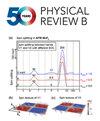Atom-wise formulation of the many-body dispersion problem for linear-scaling van der Waals corrections
IF 3.7
2区 物理与天体物理
Q1 Physics and Astronomy
引用次数: 0
Abstract
A common approach to modeling dispersion interactions and overcoming the inaccurate description of long-range correlation effects in electronic structure calculations is the use of pairwise-additive potentials, as in the Tkatchenko-Scheffler [] method. In previous work [H. Muhli , ], we have shown how these are amenable to highly efficient atomistic simulation by machine learning their local parametrization. However, the atomic polarizability and the electron correlation energy have a complex and nonlocal many-body character and some of the dispersion effects in complex systems are not sufficiently described by these types of pairwise-additive potentials. Currently, one of the most widely used rigorous descriptions of the many-body effects is based on the many-body dispersion (MBD) model [A. Tkatchenko , ]. In this work, we show that the MBD model can also be locally parametrized to derive a local approximation for the highly nonlocal many-body effects. With this local parametrization, we develop an atomwise formulation of MBD that we refer to as linear MBD (lMBD), as this decomposition enables linear scaling with system size. This model provides a transparent and controllable approximation to the full MBD model with tunable convergence parameters for a fraction of the computational cost observed in electronic structure calculations with popular density-functional theory codes. We show that our model scales linearly with the number of atoms in the system and is easily parallelizable. Furthermore, we show how using the same machinery already established in previous work for predicting Hirshfeld volumes with machine learning enables access to large-scale simulations with MBD-level corrections.求助全文
约1分钟内获得全文
求助全文
来源期刊

Physical Review B
物理-物理:凝聚态物理
CiteScore
6.70
自引率
32.40%
发文量
0
审稿时长
3.0 months
期刊介绍:
Physical Review B (PRB) is the world’s largest dedicated physics journal, publishing approximately 100 new, high-quality papers each week. The most highly cited journal in condensed matter physics, PRB provides outstanding depth and breadth of coverage, combined with unrivaled context and background for ongoing research by scientists worldwide.
PRB covers the full range of condensed matter, materials physics, and related subfields, including:
-Structure and phase transitions
-Ferroelectrics and multiferroics
-Disordered systems and alloys
-Magnetism
-Superconductivity
-Electronic structure, photonics, and metamaterials
-Semiconductors and mesoscopic systems
-Surfaces, nanoscience, and two-dimensional materials
-Topological states of matter
 求助内容:
求助内容: 应助结果提醒方式:
应助结果提醒方式:


